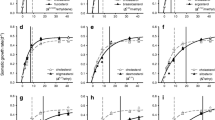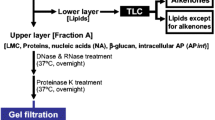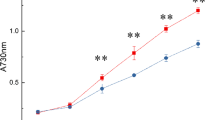Abstract
The kinetics and efficiency of sterol production and bioconversion of phytosterols in two heterotrophic protists Oxyrrhis marina and Gyrodinium dominans were examined by feeding them two different algal species (Rhodomonas salina and Dunaliella tertiolecta) differing in sterol profiles. R. salina contains predominantly brassicasterol (≅99%) and <2% cholesterol. The major sterols in D. tertiolecta are ergosterol (45–49%), 7-dehydroporiferasterol (29–31%) and fungisterol (21–26%). O. marina fed R. salina metabolized dietary brassicasterol to produce 22-dehydrocholesterol and cholesterol. O. marina fed D. tertiolecta metabolized dietary sterols to produce cholesterol, 22-dehydrocholesterol, brassicasterol and stigmasterol. G. dominans fed either R. salina or D. tertiolecta metabolized dietary sterols to make cholesterol, brassicasterol and a series of unknown sterols. When protists were fed R. salina, which contains cholesterol, the levels of cholesterol were increased to a magnitude of nearly 5- to 30-fold at the phytoplankton-heterotrophic protist interface, equivalent to a production of 172.5 ± 16.2 and 987.7 ± 377.7 ng cholesterol per mg R. salina carbon consumed by O. marina and G. dominans, respectively. When protists were fed D. tertiolecta, which contains no cholesterol, a net production of cholesterol by the protists ranged from 123.2 ± 30.6 to 871.8 ± 130.8 ng per mg algal C consumed. Cholesterol is not only the dominant sterol, but a critical precursor for many physiologically functional biochemicals in higher animal. As intermediates, these heterotrophic protists increase the amount of cholesterol at the phytoplankton–zooplankton interface available to higher trophic levels relative to zooplankton feeding on algae directly.





Similar content being viewed by others
References
Ackman RG (1989) Nutritional composition of fats in seafoods. Prog Food Nutr Sci 13:161–241
Adolf JE, Krupatkina D, Bachvaroff T, Place AR (2007) Karlotoxin mediates grazing by Oxyrrhis marina on strains of Karlodinium venificum. Harmful Algae 6:400–412
Ballantine JA, Roberts JC, Morris RJ (1980) Marine sterols: the sterols of some pelagic marine crustaceans. J Exp Mar Biol Ecol 47:25–33
Bec A, Desvilettes C, Vera A, Lemarchand C, Fontvielle D, Bourdier G (2003) Nutritional quality of a freshwater heterotrophic dinoflagellate: trophic upgrading of its microalgal diet for Daphnia hyalina. Aquat Microb Ecol 32:203–207
Bec A, Martin-Creuzburg D, Von Elert E (2006) Trophic upgrading of autotrophic picoplankton by the heterotrophic nanoflagellate Paraphysomonas sp. Limnol Oceanogr 51:1699–1707
Bligh EG, Dyer WJ (1959) A rapid method of total lipid extraction and purification. Can J Biochem Physiol 37:911–917
Boechat IG, Adrian R (2005) Biochemical composition of algivorous freshwater ciliates: you are not what you eat. FEMS Microbiol Ecol 53:393–400
Bollens GCR, Penry DL (2003) Feeding dynamics of Acartia spp. copepods in a large, temperate estuary (San Francisco Bay, CA). Mar Ecol Progr Ser 257:139–158
Bouvier F, Rahier A, Camara B (2005) Biogenesis, molecular regulation and function of plant isoprenoids. Prog Lipid Res 44:357–429
Broglio E, Jonasdottir SH, Calbet A, Jakobsen HH, Saiz E (2003) Effect of heterotrophic versus autotrophic food on feeding and reproduction of the calanoid copepod Acartia tonsa: relationship with prey fatty acid composition. Aquat Microb Ecol 31:267–278
Bruckdorfer KR, Demel RA, De Gier J, Van Deenen LLM (1969) The effect of partial replacement of membrane cholesterol by other sterols on the osmotic fragility and glycerol permeability of erythrocytes. Biochim Biophys Acta 183:334–345
Chu F-LE, Lund ED, Podbesek JA (2008) Quantitative significance of n–3 essential fatty acid contribution by heterotrophic protists and its ecological implication in marine pelagic food webs. Mar Ecol Prog Ser 354:85–95
Crockett EL (1998) Cholesterol function in plasma membranes from ectotherms: membrane- specific roles in adaptation to temperature. Am Zool 38:291–304
Crockett EL, Hassett A (2005) Cholesterol-enriched diet enhances egg production and egg viability without altering cholesterol content of biological membranes in the copepod Acartia hudsonica. Physiol Biochem Zool 78:424–433
Demel RA, Bruckendorf KR, Van Deenen LLM (1972) The effect of sterol structure on permeability of liposomes to glucose, glycerol and Rb+. Biochim Biophys Acta 255:321–330
Ederington MC, McManus GB, Harvey HR (1995) Trophic transfer of fatty acids, sterols, and a triterpenoid alcohol between bacteria, a ciliate, and the copepod Acartia tonsa. Limnol Oceanogr 40:860–867
Fingerman M (1987) The endocrine mechanisms of crustaceans. J Crustacean Biol 7:1–24
Finkelstein A, Cass A (1967) Effect of cholesterol on the water permeability of thin lipid membranes. Nature 216:717
Gealt MA, Adler JH, Nes WR (1981) The sterols and fatty acids from purified flagella of Chlamydomonas reinhardi. Lipids 16:133–136
Ghosh P, Patterson GW, Wikfors GH (1998) Sterols of some marine Prymnesiophyceae. J Phycol 34:511–514
Gifford SM, Rollwagen-Bollens G, Bollens SM (2007) Mesozooplankton omnivory in the upper San Francisco Estuary. Mar Ecol Prog Ser 348:33–46
Goad LJ, Holz GG, Beach DH (1983) Identification of (24 s) 24-methylcholesta-5, 22-diene-3Β-ol as the major sterol of a marine cryptophyte and a marine prymnesiophyte. Phytochemistry 22:475–476
Goodwin TW (1980) Biosynthesis of sterols. In: Stumpf PK (ed) The biochemistry of plants, vol 4. Academic Press, New York NY, pp 485–507
Gurr MI, Harwood JL, Frayn KN (2002) Lipid biochemistry, 5th edn. Blackwell Sciences Inc, Malden
Harvey HR, Ederington MC, McManus GB (1997) Lipid composition of the marine ciliates Pleuronema sp. and Fabrea salina: Shifts in response to changes in diet. J Eukaryot Microbiol 44:189–193
Hassett RP (2004) Supplementation of a diatom diet with cholesterol can enhance copepod egg-production rates. Limnol Oceanogr 49:488–494
Kanazawa A (2001) Sterols in marine invertebrates. Fisheries Sci 67:997–1007
Klein Breteler WCM, Schogt N, Baas M, Schouten S, Kraay GW (1999) Trophic upgrading of food quality by protozoans enhancing copepod growth: role of essential lipids. Mar Biol 135:191–198
Klein Breteler WCM, Koski M, Rampen S (2004) Role of essential lipids in copepod nutrition: no evidence of trophic upgrading of food quality by a marine ciliate. Mar Ecol Prog Ser 274:199–208
Klein Breteler WCM, Schogt N, Rampen S (2005) Effect of diatom nutrient limitation on copepod development: role of essential lipids. Mar Ecol Prog Ser 291:125–133
Leblond JD, Chapman PJ (2002) A survey of the sterol composition of the marine dinoflagellates Karenia brevis, Karenia mikimotoi, and Karlodinium micrum: distribution of sterols within other members of the class Dinophyceae. J Phycol 38:670–682
Leblond JD, Chapman PJ (2004) Sterols of the heterotrophic dinoflagellate, Pfiesteria piscicida (Dinophyceae): is there a lipid biomarker? J Phycol 40:104–111
Leblond JD, Sengco MR, Sickman JO, Dahmen JL, Anderson DM (2006) Sterols of the syndinian dinoflagellate Amoebophrya sp., a parasite of the dinoflagellate Alexandrium tamarense (Dinophyceae). J Eukaryot Microbiol 53:211–216
Lund ED, Chu F-LE, Harvey E, Adolf R (2008) Mechanism(s) of long chain n-3 essential fatty acid production in two species of heterotrophic protists: Oxyrrhis marina and Gyrodinium dominans. Mar Biol 155:23–36
Martin-Creuzburg D, Von Elert E (2004) Impact of 10 dietary sterols on growth and reproduction of Daphnia galeata. J Chem Ecol 30:483–500
Martin-Creuzburg D, Bec A, Von Elert E (2005a) Trophic upgrading of picocyanobacterial carbon by ciliates for nutrition of Daphnia magna. Aquat Microb Ecol 41:271–280
Martin-Creuzburg D, Wacker A, Von Elert E (2005b) Life history consequences of sterol availability in the aquatic keystone species Daphnia. Oecologia 144:362–372
Martin-Creuzburg D, Bec A, Von Elert E (2006) Supplementation with sterols improves food quality of a ciliate for Daphnia magna. Protist 157:477–486
Martin-Creuzburg D, Von Elert E, Hoffmann K (2008) Nutritional constraints at the cyanobacteria-Daphnia magna interface: The role of sterols. Limnol Oceanogr 53:456–468
Merrell JR, Stoecker DK (1998) Differential grazing on protozoan microplankton by developmental stages of the calanoid copepod Eurytemora affinis. J Plankton Res 20:289–304
Ohman MD, Runge JA (1994) Sustained fecundity when phytoplankton resources are in short supply: Omnivory by Calanus finmarchicus in the Gulf of St. Lawrence. Limnol Oceanogr 39:21–36
Patterson GW, Gladu PK, Wikfors GH, Lusby WR (1992) Unusual tetraene sterols in some phytoplankton. Lipids 27:154–156
Prahl FG, Eglinton G, Corner EDS, O’Hara SCM, Forsberg TEV (1984) Changes in plant lipids during passage through the gut of Calanus. J Mar Biol Ass UK 64:317–334
Smith WJ, Marra J, Hiscock M, Barber R (2000) The seasonal cycle of phytoplankton biomass and primary productivity in the Ross Sea. Antarctica Deep Sea Res (II Top Stud Oceanogr) 47:3119–3140
Soudant P, Marty Y, Moal J, Robert R, Quere C, Le Coz JR, Samain JF (1996) Effect of food fatty acid and sterol quality on Pecten maximus gonad composition and reproduction process. Aquaculture 143:361–378
Soudant P, Le Coz JR, Marty Y, Moal J, Robert R, Samain JF (1998) Incorporation of microalgae sterols by scallop Pecten maximus (L.) larvae. Comp Biochem Physiol 119A:451–457
St. John MA, Lund T (1996) Lipid biomarkers: linking the utilization of frontal plankton biomass to enhanced condition of juvenile North Sea cod. Mar Ecol Prog Ser 131:75–85
St. John MA, Clemmesen C, Lund T, Koester T (2001) Diatom production in the marine environment: implications for larval fish growth and condition. ICES J Mar Sci 58:1106–1113
Tang K, Taal M (2005) Trophic modification of food quality by heterotrophic protists: species-specific effects on copepod egg production and egg hatching. J Exp Mar Biol Ecol 318:85–98
Veloza AJ, Chu F-E, Tang KW (2006) Trophic modification of essential fatty acids by heterotrophic protists and its effects on the fatty acid composition of the copepod Acartia tonsa. Mar Biol 148:779–788
Volkman JK (2003) Sterols in microorganisms. Appl Microbiol Biotechnol 60:495–506
Von Elert E, Martin-Creuzburg D, Le Coz JR (2003) Absence of sterols constrains carbon transfer between cyanobacteria and a freshwater herbivore (Daphnia galeata). Proc R Soc London B 270:1209–1214
Zelazny AM, Shaish A, Pick U (1995) Plasma membrane sterols are essential for sensing osmotic changes in the halotolerant alga Dunaliella. Plant Physiol 109:1395–1403
Acknowledgments
This study was supported by OCE, NSF (award #:0525899). The authors are grateful for Jenny Dryer’s help on the analysis of protist and algal carbon content. Contribution no. 2973 by the Virginia Institute of Marine Science, College of William and Mary.
Author information
Authors and Affiliations
Corresponding author
Additional information
Communicated by U.-G. Berninger.
Rights and permissions
About this article
Cite this article
Chu, FL.E., Lund, E.D., Littreal, P.R. et al. Sterol production and phytosterol bioconversion in two species of heterotrophic protists, Oxyrrhis marina and Gyrodinium dominans . Mar Biol 156, 155–169 (2008). https://doi.org/10.1007/s00227-008-1072-2
Received:
Accepted:
Published:
Issue Date:
DOI: https://doi.org/10.1007/s00227-008-1072-2




